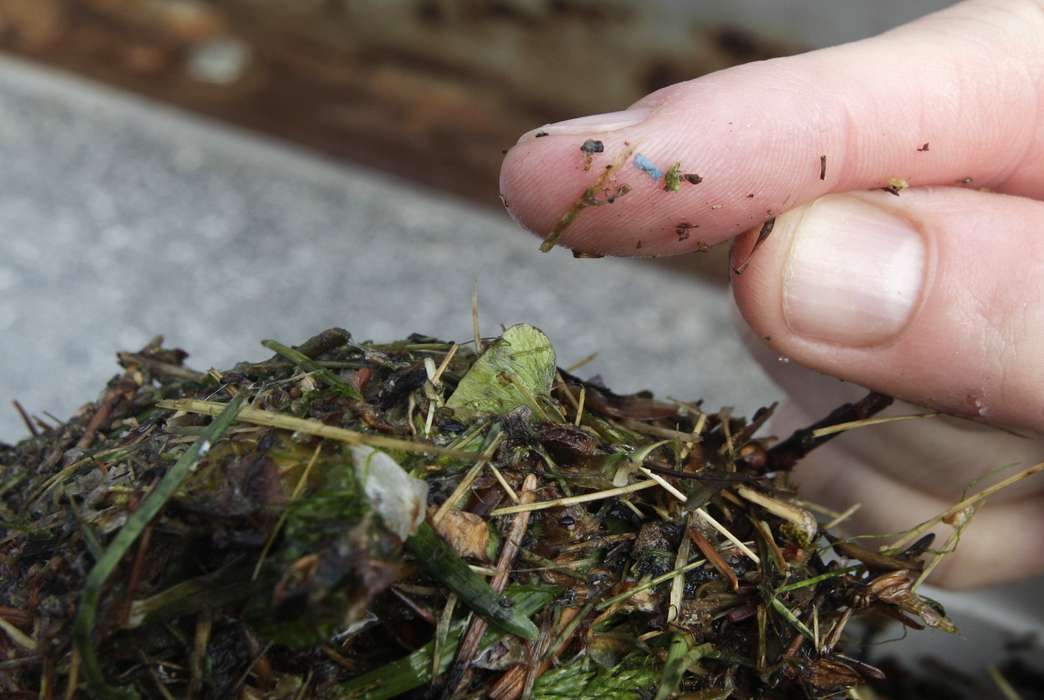Biodegradables could be worse than regular plastics in an important way

"Compostable plastic" might shed more microplastics than conventional polymers. (AP Photo/Ted S. Warren)
A commonly used biodegradable plastic generated more tiny plastic fragments than a comparable conventional polymer, according to a lab-based pilot study that suggests compostable alternatives may not be as environmentally friendly as they seem.
Biodegradable polymers such as butylene adipate-co-terephthalate, more commonly known as PBAT, can break down within months. But little is known about whether this material produces microplastics as it decomposes, according to researchers who investigated PBAT degradation in freshwater and saltwater conditions. Their findings were published April 6 in Water Research.
Millions of tons of plastic waste end up in oceans and rivers each year, a problem that isn't going away anytime soon, because conventional plastic polymers take decades or centuries to decompose. Biodegradable polymers are considered one potential solution to this problem.
"I think a general belief is that because it's biodegradable, it's of no concern; it degrades, and there will be no microplastics," said study co-author Mikael Hedenqvist, a professor of polymeric materials at KTH Royal Institute for Technology, in Sweden. "What we show here is that microplastics can form faster from a biodegradable polymer than from a persistent one."
From soils to the sea, microplastics are found in almost every habitat on Earth. These tiny fragments of plastic, measuring 5 millimeters or less, can enter food chains and harm plants, animals and even humans.
There are two main sources of microplastics, explained lead author Xin-Feng Wei, a postdoctoral researcher at KTH Royal Institute for Technology who conducted some of the work as a researcher at RISE Research Institutes of Sweden. Primary sources are generated intentionally for applications such as cosmetics and clothing.
"Secondary sources are from plastic waste," he added. "Plastic waste is very resistant in nature, but it can be degraded under natural forces such as waves, tides and UV light from sunlight, so they break down to small pieces."
Wei, Hedenqvist and their colleagues investigated decomposition of PBAT, which is commonly used in single-use bags and as agricultural plastic mulch. The researchers placed pieces of PBAT plastic film into containers of freshwater or saltwater, some of which they treated with UV light.
"These plastics often experience UV degradation before they end up in the river or the sea," Wei explained. "UV light can accelerate the process of microplastic formation."
After the plastic and water samples were incubated for 10 weeks, the researchers used scanning electron microscopy to examine microplastics. As expected, they found that PBAT produced more microplastics in the UV treatments than it did when not exposed to UV light. They also found that the polymer generated more microplastics in saltwater conditions than in freshwater, likely due to differences in pH.
The team also compared the amount of microplastics produced by PBAT and low-density polyethylene, or LDPE, a comparable conventional plastic. In freshwater conditions, PBAT produced more than double the amount of microplastics produced by LDPE.
"Microplastics can form faster from a biodegradable polymer than from a persistent one," Hedenqvist noted. He said this finding highlights, "One should be careful in choosing biodegradable polymers from a microplastics perspective. ... You have to consider that biodegradable polymers also cause microplastics; it's not just the long-term persistent polymers that do so."
The researchers have acknowledged that their findings are preliminary and that their lab-based experiments may not fully replicate what happens in the environment. In addition, because they compared just two plastics, Hedenqvist said that more work is needed to make general conclusions about microplastics formed by biodegradable polymers.
Like their conventional counterparts, biodegradable plastics are produced from fossil fuels, whereas the similarly named bio-based plastics are made from biological materials such as fish oil or plants. A recent study also found that a different biodegradable plastic and a bio-based plastic both produced microplastics in a salt marsh.
According to Wei, the environmental impacts of microplastics generated from biodegradable plastics are poorly known, although another recent study found that microplastics from LDPE or a blend of PBAT and polylactide, another biodegradable plastic, reduced reproduction of soil-dwelling nematodes.
The study, "Microplastics generated from a biodegradable plastic in freshwater and seawater," published April 6 in Water Research, was authored by Xin-Feng Wei and Mikael Hedenqvis, KTH Royal Institute for Technology; and Martin Bohlén, Catrin Lindblad and Aron Hakonen, RISE Research Institutes of Sweden.
